最新英语综合实践课教案3
- 格式:docx
- 大小:15.70 KB
- 文档页数:3
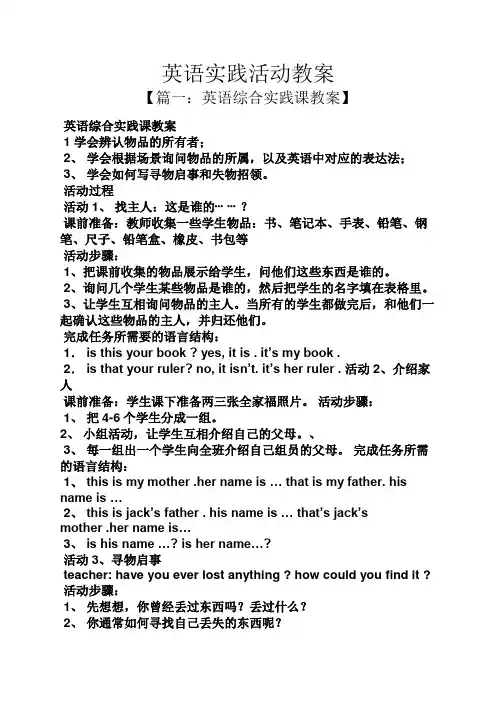
英语实践活动教案【篇一:英语综合实践课教案】英语综合实践课教案1 学会辨认物品的所有者;2、学会根据场景询问物品的所属,以及英语中对应的表达法;3、学会如何写寻物启事和失物招领。
活动过程活动1、找主人:这是谁的┅┅?课前准备:教师收集一些学生物品:书、笔记本、手表、铅笔、钢笔、尺子、铅笔盒、橡皮、书包等活动步骤:1、把课前收集的物品展示给学生,问他们这些东西是谁的。
2、询问几个学生某些物品是谁的,然后把学生的名字填在表格里。
3、让学生互相询问物品的主人。
当所有的学生都做完后,和他们一起确认这些物品的主人,并归还他们。
完成任务所需要的语言结构:1.is this your book ? yes, it is . it’s my book .2.is that your ruler? no, it isn’t. it’s her ruler . 活动2、介绍家人课前准备:学生课下准备两三张全家福照片。
活动步骤:1、把4-6个学生分成一组。
2、小组活动,让学生互相介绍自己的父母。
、3、每一组出一个学生向全班介绍自己组员的父母。
完成任务所需的语言结构:1、this is my mother .her name is … that is my father. his name is …2、this is jack’s father . his name is … that’s jack’smother .her name is…3、is his name …? is her name…?活动3、寻物启事teacher: have you ever lost anything ? how could you find it ?活动步骤:1、先想想,你曾经丢过东西吗?丢过什么?2、你通常如何寻找自己丢失的东西呢?3、写一份寻物启事,来寻找你丢失的东西。
4、四人一组,把你的寻物启事读给你同组的人听。
完成任务所需要的语言结构:1.my book is …2.my name is …3.please call 928-6820【篇二:英语综合实践活动课教案】英语综合实践活动课教案第一:活动设计目的:1、新课标背景下的英语教学,要求教师应尽可能创设情景努力激发和培养学生学习英语的兴趣与热情,使学生能够掌握一定的英语基础和听、说、读、写技能。
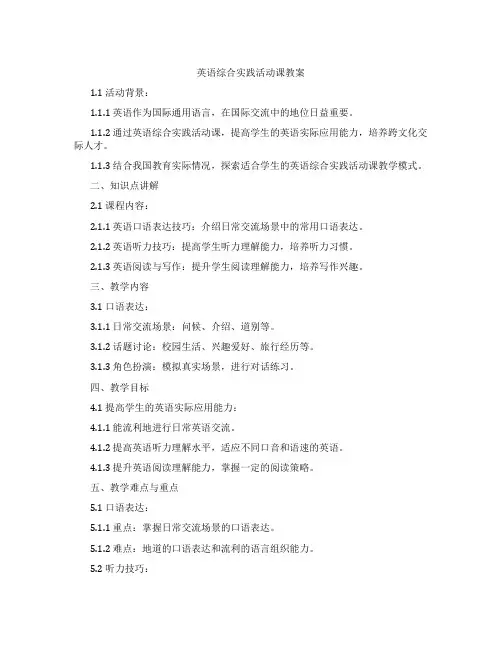
英语综合实践活动课教案1.1 活动背景:1.1.1 英语作为国际通用语言,在国际交流中的地位日益重要。
1.1.2 通过英语综合实践活动课,提高学生的英语实际应用能力,培养跨文化交际人才。
1.1.3 结合我国教育实际情况,探索适合学生的英语综合实践活动课教学模式。
二、知识点讲解2.1 课程内容:2.1.1 英语口语表达技巧:介绍日常交流场景中的常用口语表达。
2.1.2 英语听力技巧:提高学生听力理解能力,培养听力习惯。
2.1.3 英语阅读与写作:提升学生阅读理解能力,培养写作兴趣。
三、教学内容3.1 口语表达:3.1.1 日常交流场景:问候、介绍、道别等。
3.1.2 话题讨论:校园生活、兴趣爱好、旅行经历等。
3.1.3 角色扮演:模拟真实场景,进行对话练习。
四、教学目标4.1 提高学生的英语实际应用能力:4.1.1 能流利地进行日常英语交流。
4.1.2 提高英语听力理解水平,适应不同口音和语速的英语。
4.1.3 提升英语阅读理解能力,掌握一定的阅读策略。
五、教学难点与重点5.1 口语表达:5.1.1 重点:掌握日常交流场景的口语表达。
5.1.2 难点:地道的口语表达和流利的语言组织能力。
5.2 听力技巧:5.2.1 重点:提高听力理解能力。
5.2.2 难点:适应不同口音和语速的英语听力。
5.3 阅读与写作:5.3.1 重点:提升阅读理解能力。
5.3.2 难点:运用阅读策略和提高写作水平。
六、教具与学具准备6.1 教具:6.1.1 教学PPT:包含课程内容、听力材料、阅读材料等。
6.1.2 实物道具:如图片、卡片等,用于情景模拟和角色扮演。
6.1.3 音响设备:用于播放听力材料。
6.2 学具:6.2.1 笔记本:用于记录重点知识和练习。
6.2.2 练习册:用于巩固所学知识和技能。
6.2.3 词汇卡片:用于学习和复习词汇。
七、教学过程7.1 导入:7.1.1 热身活动:简单的英语口语练习,如问候、自我介绍等。
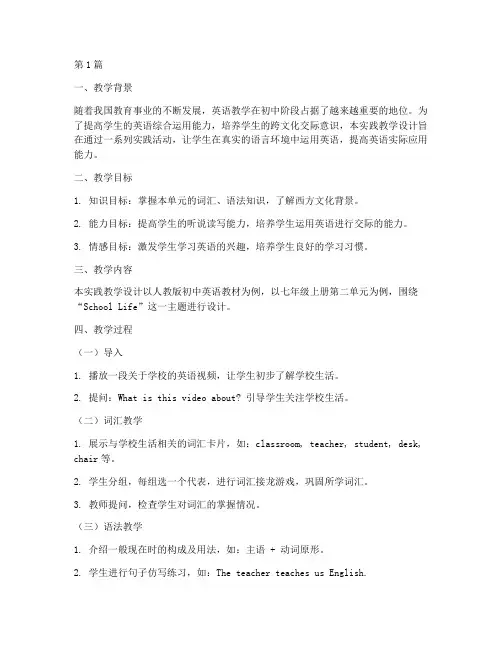
第1篇一、教学背景随着我国教育事业的不断发展,英语教学在初中阶段占据了越来越重要的地位。
为了提高学生的英语综合运用能力,培养学生的跨文化交际意识,本实践教学设计旨在通过一系列实践活动,让学生在真实的语言环境中运用英语,提高英语实际应用能力。
二、教学目标1. 知识目标:掌握本单元的词汇、语法知识,了解西方文化背景。
2. 能力目标:提高学生的听说读写能力,培养学生运用英语进行交际的能力。
3. 情感目标:激发学生学习英语的兴趣,培养学生良好的学习习惯。
三、教学内容本实践教学设计以人教版初中英语教材为例,以七年级上册第二单元为例,围绕“School Life”这一主题进行设计。
四、教学过程(一)导入1. 播放一段关于学校的英语视频,让学生初步了解学校生活。
2. 提问:What is this video about? 引导学生关注学校生活。
(二)词汇教学1. 展示与学校生活相关的词汇卡片,如:classroom, teacher, student, desk, chair等。
2. 学生分组,每组选一个代表,进行词汇接龙游戏,巩固所学词汇。
3. 教师提问,检查学生对词汇的掌握情况。
(三)语法教学1. 介绍一般现在时的构成及用法,如:主语 + 动词原形。
2. 学生进行句子仿写练习,如:The teacher teaches us English.3. 教师巡视指导,纠正错误。
(四)听力训练1. 播放一段关于学校生活的英语听力材料,让学生根据听力内容回答问题。
2. 教师总结听力技巧,如:关注关键词,注意语音语调等。
(五)阅读训练1. 分发课文,让学生自主阅读,了解文章大意。
2. 教师提问,检查学生对文章的理解。
3. 学生分组讨论,分享阅读心得。
(六)口语交际1. 教师设置情景,如:介绍自己的学校,询问同学的学校等。
2. 学生分组进行口语交际练习,教师巡视指导。
(七)总结与反思1. 教师总结本节课所学内容,强调重点和难点。
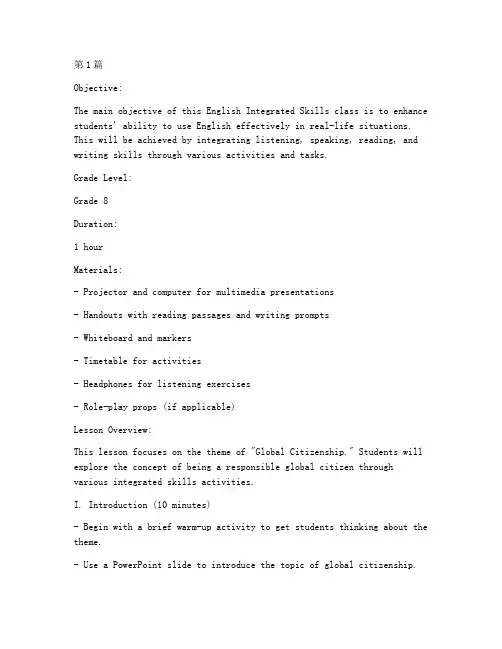
第1篇Objective:The main objective of this English Integrated Skills class is to enhance students' ability to use English effectively in real-life situations. This will be achieved by integrating listening, speaking, reading, and writing skills through various activities and tasks.Grade Level:Grade 8Duration:1 hourMaterials:- Projector and computer for multimedia presentations- Handouts with reading passages and writing prompts- Whiteboard and markers- Timetable for activities- Headphones for listening exercises- Role-play props (if applicable)Lesson Overview:This lesson focuses on the theme of "Global Citizenship." Students will explore the concept of being a responsible global citizen through various integrated skills activities.I. Introduction (10 minutes)- Begin with a brief warm-up activity to get students thinking about the theme.- Use a PowerPoint slide to introduce the topic of global citizenship.- Ask students to share their initial thoughts and ideas about what it means to be a global citizen.II. Listening and Note-Taking (15 minutes)- Play a short audio clip related to global citizenship (e.g., a TEDTalk or a news report).- Instruct students to listen actively and take notes on key points.- Pause the audio at intervals and ask students to share their notes and discuss the information they have gathered.III. Reading and Discussion (20 minutes)- Distribute a handout with a reading passage on global citizenship.- Encourage students to read the passage silently and then discuss it in pairs or small groups.- Ask questions to guide the discussion, such as:- What are the main challenges faced by global citizens?- How can individuals contribute to global issues?- What are some positive examples of global citizenship?IV. Speaking and Role-Play (15 minutes)- Divide the class into groups of three or four.- Assign each group a scenario related to global citizenship (e.g., environmental conservation, cultural exchange, or social justice).- Instruct students to prepare a short role-play based on their scenario, using the information from the listening and reading activities.- Have each group present their role-play to the class, and thenfacilitate a discussion about the scenarios.V. Writing and Reflection (20 minutes)- Provide students with a writing prompt related to global citizenship (e.g., "How can you be a more responsible global citizen in your daily life?").- Instruct students to write a short essay or journal entry in response to the prompt.- Encourage students to reflect on their own experiences and ideas, and to use evidence from the lesson to support their arguments.VI. Conclusion and Assessment (10 minutes)- Summarize the key points of the lesson and reinforce the importance of global citizenship.- Conduct a quick assessment of the students' understanding by asking them to share one thing they learned or one action they plan to take as a result of the lesson.- Provide feedback on the students' writing and encourage them to continue exploring the theme of global citizenship in their own time.Assessment Criteria:- Active participation in all activities- Accuracy and fluency in speaking and listening- Clarity and coherence in writing- Depth of understanding and application of the themeExtensions:- Assign a research project on a specific global issue for homework.- Organize a school-wide event or campaign to promote global citizenship.- Invite a guest speaker from a relevant organization to discuss the topic with the class.Evaluation:This lesson will be evaluated based on students' engagement in activities, the quality of their writing, and their ability to demonstrate an understanding of the theme of global citizenship. Formative assessments will be used throughout the lesson to monitor progress and provide feedback. Summative assessments will be conducted at the end of the lesson to evaluate the overall effectiveness of the teaching strategies and activities.第2篇Objective:The objective of this English comprehensive practice class is to enhance students' overall English proficiency through various activities that focus on reading, writing, speaking, and listening skills. The class aims to create an interactive and engaging learning environment that encourages students to apply their language skills in real-life situations.Subject: EnglishGrade Level: 8th GradeDuration: 2 hoursMaterials:- Projector and computer for multimedia presentations- Whiteboard and markers- Handouts with reading materials- Writing materials (pens, pencils, notebooks)- Flashcards for vocabulary practice- English songs or audio clips for listening practice- Role-playing props or costumes (optional)Lesson Overview:This lesson will be divided into four main sections: reading, writing, speaking, and listening. Each section will have specific activities designed to develop the respective skills. The activities will be interactive, allowing students to work individually, in pairs, or in groups.I. Introduction (10 minutes)1. Greet the students and review the objectives of the lesson.2. Briefly explain the structure of the class and what each section will entail.II. Reading (20 minutes)1. Distribute handouts with reading materials relevant to the unit's theme.2. Students will read the material silently for 5 minutes.3. Facilitate a group discussion on the reading material, asking guiding questions to encourage critical thinking.4. Assign a reading comprehension task, such as summarizing the main points or identifying the author's purpose.III. Writing (25 minutes)1. Introduce a writing prompt related to the reading material or a current event.2. Students will write a short essay or paragraph based on the prompt, focusing on proper grammar, punctuation, and vocabulary usage.3. Provide students with a checklist to self-assess their writing.4. Peer-editing session: Students will exchange their writings with a partner and provide constructive feedback.5. Teacher will provide individual feedback on selected essays.IV. Speaking (15 minutes)1. Divide the class into small groups.2. Assign each group a role-play scenario based on the unit's theme.3. Provide students with a list of vocabulary and phrases that may be useful for their role-play.4. Allow each group 5 minutes to practice their role-play.5. Conduct a round of role-plays, with each group presenting their scenario to the class.6. Facilitate a class discussion on the role-plays, encouraging students to analyze the characters' motivations and actions.V. Listening (10 minutes)1. Play an English song or an audio clip related to the unit's theme.2. Students will listen to the audio and answer comprehension questions.3. Discuss the content of the audio and its relevance to the unit's topic.4. Assign a listening comprehension task, such as filling in missing words or identifying the main idea.VI. Conclusion (10 minutes)1. Recap the main points of the lesson, emphasizing the importance of each skill.2. Provide students with a homework assignment that reinforces theskills learned in class.3. Thank the students for their participation and encourage them to continue practicing their English skills outside of the classroom.Assessment:The assessment of this lesson will be based on the following criteria:- Participation and engagement in class activities- Quality of writing and ability to follow the checklist- Performance in role-plays and ability to apply learned vocabulary- Comprehension and understanding of the reading and listening materialsHomework:1. Students will write a short story or journal entry using the vocabulary and themes covered in the lesson.2. Students will listen to an English podcast or watch an English video related to the unit's theme and complete a listening comprehension worksheet.This English comprehensive practice class aims to provide a well-rounded approach to language learning, encouraging students to develop their reading, writing, speaking, and listening skills through interactive and engaging activities.第3篇Objective:The main objective of this English comprehensive practical class is to enhance students' ability to use English in real-life situations, promote their cultural awareness, and foster their critical thinking skills. The class will focus on integrating language learning with practical activities, cultural exploration, and collaborative learning.Duration:Two hoursGrade Level:Grade 7Class Size:30 studentsMaterials Needed:- Projector and computer for presentations- Whiteboard and markers- Handouts (maps, travel brochures, cultural articles)- Interactive online resources (websites, videos, quizzes)- Group work materials (notebooks, pens, scissors, glue)- World mapLesson Overview:1. Introduction (10 minutes)- Welcome and icebreaker activity to get students comfortable with the class environment.- Briefly introduce the topic of the class: Exploring the World Through English.2. Cultural Awareness (15 minutes)- Present a short video clip showcasing different cultures around the world.- Discuss the cultural aspects presented in the video, emphasizing the importance of cultural sensitivity and understanding.3. Language in Use (20 minutes)- Introduce key vocabulary related to travel and cultural exploration (e.g., “adventure,” “sightseeing,” “local cuisine”).- Conduct a role-play activity where students act out a conversation between two tourists and a local guide.- Provide feedback and correct any grammatical errors.4. Interactive Presentation (15 minutes)- Each student selects a country from a world map and presents abrief overview of its culture, history, and famous landmarks.- Use the projector to display relevant images and information.5. Group Activity: Travel Brochure Creation (30 minutes)- Divide the class into groups of three or four.- Each group is given a list of countries and must create a travel brochure for one of the countries.- The brochure should include information about the country’s culture, popular attractions, and tips for tourists.- Students must use the target language (English) to convey their information.6. Collaborative Review (15 minutes)- Each group presents their travel brochure to the class.- The class provides feedback and suggestions for improvement.- The teacher circulates and offers additional support as needed.7. Cultural Exchange (15 minutes)- Students exchange brochures with another group and take turns presenting the information to their peers.- This activity encourages students to engage with the material from different perspectives and deepen their understanding.8. Reflection and Conclusion (10 minutes)- Conduct a brief reflection activity where students write down one thing they learned about another culture and one thing they would like to explore in the future.- Summarize the main points of the class and encourage students to continue exploring the world through English in their daily lives.Assessment:- Participation in class activities and discussions.- Quality and creativity of the travel brochure.- Reflection writing.- Homework assignment: Students will write a short essay on their favorite country from the class and explain why they find it interesting.Additional Notes:- Encourage students to use technology and online resources to research their chosen countries.- Provide opportunities for students to correct each other’s work and learn from each other’s mistakes.- Ensure that the classroom environment is inclusive and respectful of all cultures.- Adjust the difficulty level of the activities according to the students’ proficiency levels.By the end of this comprehensive practical class, students should have a better understanding of different cultures, improved their English language skills, and developed a passion for exploring the world through language.。
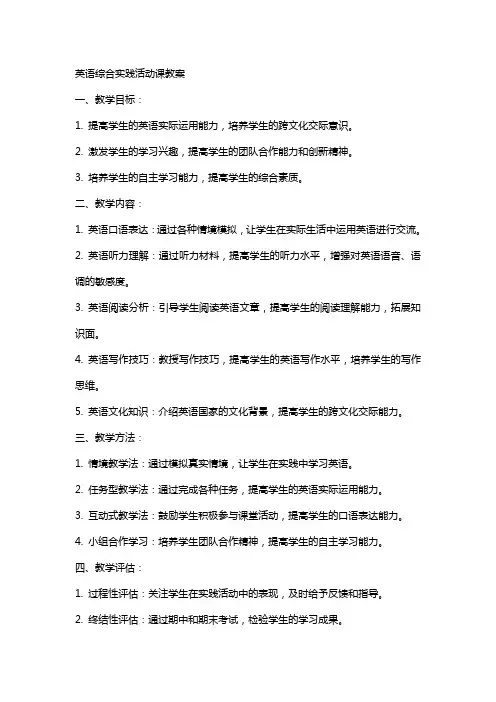
英语综合实践活动课教案一、教学目标:1. 提高学生的英语实际运用能力,培养学生的跨文化交际意识。
2. 激发学生的学习兴趣,提高学生的团队合作能力和创新精神。
3. 培养学生的自主学习能力,提高学生的综合素质。
二、教学内容:1. 英语口语表达:通过各种情境模拟,让学生在实际生活中运用英语进行交流。
2. 英语听力理解:通过听力材料,提高学生的听力水平,增强对英语语音、语调的敏感度。
3. 英语阅读分析:引导学生阅读英语文章,提高学生的阅读理解能力,拓展知识面。
4. 英语写作技巧:教授写作技巧,提高学生的英语写作水平,培养学生的写作思维。
5. 英语文化知识:介绍英语国家的文化背景,提高学生的跨文化交际能力。
三、教学方法:1. 情境教学法:通过模拟真实情境,让学生在实践中学习英语。
2. 任务型教学法:通过完成各种任务,提高学生的英语实际运用能力。
3. 互动式教学法:鼓励学生积极参与课堂活动,提高学生的口语表达能力。
4. 小组合作学习:培养学生团队合作精神,提高学生的自主学习能力。
四、教学评估:1. 过程性评估:关注学生在实践活动中的表现,及时给予反馈和指导。
2. 终结性评估:通过期中和期末考试,检验学生的学习成果。
3. 自我评估:鼓励学生进行自我反思,提高学生的自我学习能力。
五、教学资源:1. 教材:选用适合学生水平的英语教材,提供丰富的学习资源。
2. 多媒体设备:利用多媒体课件,增加课堂趣味性,提高教学效果。
3. 网络资源:利用网络资源,拓宽学生的学习渠道,提高学生的自主学习能力。
4. 实物教具:使用实物教具,增强学生的直观感受,提高教学效果。
六、教学进程安排:1. 第一阶段:英语口语表达训练(2周)通过情境模拟、角色扮演等方式,让学生在实际生活中运用英语进行交流。
2. 第二阶段:英语听力理解训练(2周)选用不同主题的听力材料,提高学生的听力水平,增强对英语语音、语调的敏感度。
3. 第三阶段:英语阅读分析训练(2周)引导学生阅读英语文章,提高学生的阅读理解能力,拓展知识面。
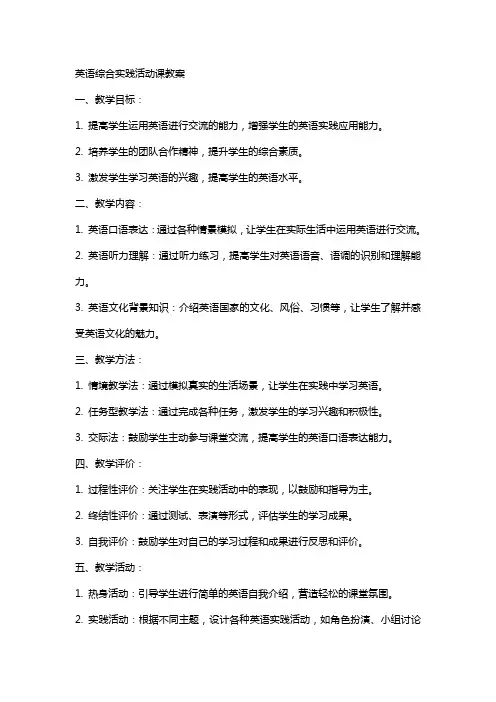
英语综合实践活动课教案一、教学目标:1. 提高学生运用英语进行交流的能力,增强学生的英语实践应用能力。
2. 培养学生的团队合作精神,提升学生的综合素质。
3. 激发学生学习英语的兴趣,提高学生的英语水平。
二、教学内容:1. 英语口语表达:通过各种情景模拟,让学生在实际生活中运用英语进行交流。
2. 英语听力理解:通过听力练习,提高学生对英语语音、语调的识别和理解能力。
3. 英语文化背景知识:介绍英语国家的文化、风俗、习惯等,让学生了解并感受英语文化的魅力。
三、教学方法:1. 情境教学法:通过模拟真实的生活场景,让学生在实践中学习英语。
2. 任务型教学法:通过完成各种任务,激发学生的学习兴趣和积极性。
3. 交际法:鼓励学生主动参与课堂交流,提高学生的英语口语表达能力。
四、教学评价:1. 过程性评价:关注学生在实践活动中的表现,以鼓励和指导为主。
2. 终结性评价:通过测试、表演等形式,评估学生的学习成果。
3. 自我评价:鼓励学生对自己的学习过程和成果进行反思和评价。
五、教学活动:1. 热身活动:引导学生进行简单的英语自我介绍,营造轻松的课堂氛围。
2. 实践活动:根据不同主题,设计各种英语实践活动,如角色扮演、小组讨论等。
3. 听力练习:选择适合学生水平的英语听力材料,进行听力训练。
4. 文化讲解:介绍相关英语国家的文化背景,让学生了解并感受英语文化的魅力。
5. 总结与反馈:对学生的实践活动进行总结和评价,鼓励学生继续努力。
六、教学准备:1. 教材:选择适合学生的英语综合实践活动教材或自编教材。
2. 教学资源:准备相关的听力材料、文化背景知识资料、实践活动指导资料等。
3. 教学设备:投影仪、电脑、音响等教学设备。
七、教学步骤:1. 导入:通过热身活动,引导学生进入英语学习状态。
2. 教学内容展示:介绍本节课的主题和教学内容。
3. 实践活动:分组进行实践活动,教师巡回指导。
4. 听力练习:播放听力材料,学生完成相关练习。
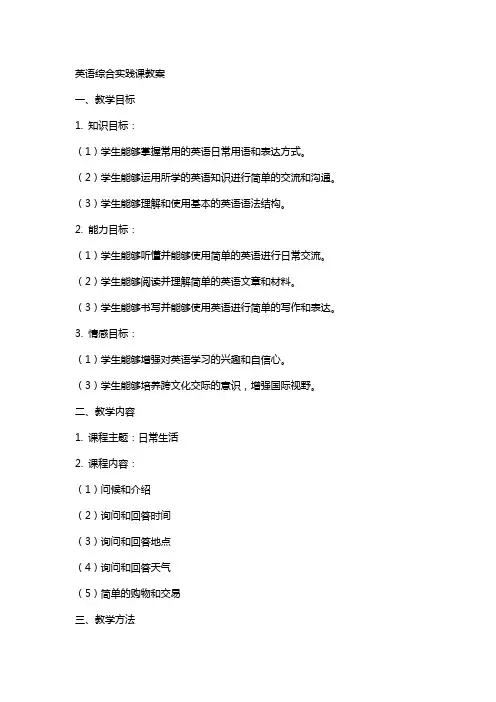
英语综合实践课教案一、教学目标1. 知识目标:(1)学生能够掌握常用的英语日常用语和表达方式。
(2)学生能够运用所学的英语知识进行简单的交流和沟通。
(3)学生能够理解和使用基本的英语语法结构。
2. 能力目标:(1)学生能够听懂并能够使用简单的英语进行日常交流。
(2)学生能够阅读并理解简单的英语文章和材料。
(3)学生能够书写并能够使用英语进行简单的写作和表达。
3. 情感目标:(1)学生能够增强对英语学习的兴趣和自信心。
(3)学生能够培养跨文化交际的意识,增强国际视野。
二、教学内容1. 课程主题:日常生活2. 课程内容:(1)问候和介绍(2)询问和回答时间(3)询问和回答地点(4)询问和回答天气(5)简单的购物和交易三、教学方法1. 交际法:通过模拟真实情境,让学生在实际交流中学习和使用英语。
2. 任务型教学法:通过完成具体的任务,让学生在实践中学习和运用英语。
3. 合作学习法:通过小组合作和互动,让学生在交流中学习,提高语言运用能力。
四、教学步骤1. 热身活动(5分钟):通过简单的英语歌曲或游戏,让学生放松气氛,调动学习积极性。
2. 课程导入(10分钟):教师引导学生复习已学的相关知识,为新课程的学习做好铺垫。
3. 新课程学习(20分钟):教师讲解新的知识点,并通过示例、练习等方式让学生进行实际操作和练习。
4. 实践环节(15分钟):学生分组进行角色扮演或完成任务,运用所学知识进行实际交流。
5. 总结与反馈(5分钟):教师对学生的表现进行点评和反馈,指出优点和需要改进的地方。
五、教学评价1. 过程评价:观察学生在课堂上的参与程度、态度和表现,以及对任务的完成情况进行评价。
2. 结果评价:通过定期的测试和考试,评估学生对知识的掌握程度和运用能力。
3. 自我评价:鼓励学生进行自我反思和评价,培养学生的自我学习能力。
六、教学资源1. 教材:选用适合学生水平的英语综合实践课教材。
2. 辅助材料:提供相关的图片、图表、音频、视频等资源,以丰富教学内容。
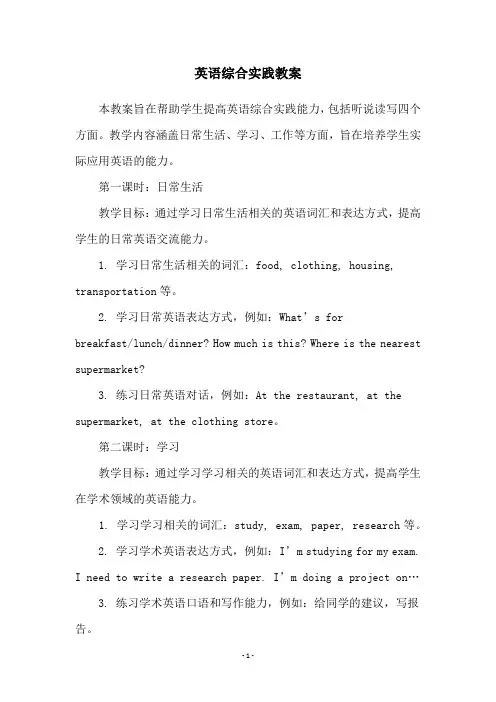
英语综合实践教案本教案旨在帮助学生提高英语综合实践能力,包括听说读写四个方面。
教学内容涵盖日常生活、学习、工作等方面,旨在培养学生实际应用英语的能力。
第一课时:日常生活教学目标:通过学习日常生活相关的英语词汇和表达方式,提高学生的日常英语交流能力。
1. 学习日常生活相关的词汇:food, clothing, housing, transportation等。
2. 学习日常英语表达方式,例如:What’s forbreakfast/lunch/dinner? How much is this? Where is the nearest supermarket?3. 练习日常英语对话,例如:At the restaurant, at the supermarket, at the clothing store。
第二课时:学习教学目标:通过学习学习相关的英语词汇和表达方式,提高学生在学术领域的英语能力。
1. 学习学习相关的词汇:study, exam, paper, research等。
2. 学习学术英语表达方式,例如:I’m studying for my exam.I need to write a research paper. I’m doing a project on…3. 练习学术英语口语和写作能力,例如:给同学的建议,写报告。
第三课时:工作教学目标:通过学习工作相关的英语词汇和表达方式,提高学生在职场的英语能力。
1. 学习工作相关的词汇:job, interview, resume, deadline 等。
2. 学习职场英语表达方式,例如:I have an interview tomorrow.I need to update my resume. What’s the deadline for this project?3. 练习职场英语交流能力,例如:模拟面试,写求职信。
第四课时:文化教学目标:通过学习文化相关的英语词汇和表达方式,提高学生对英语国家文化的认识。
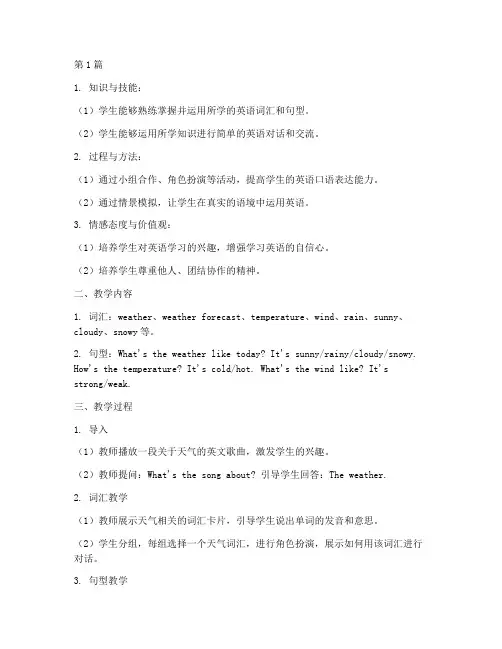
第1篇1. 知识与技能:(1)学生能够熟练掌握并运用所学的英语词汇和句型。
(2)学生能够运用所学知识进行简单的英语对话和交流。
2. 过程与方法:(1)通过小组合作、角色扮演等活动,提高学生的英语口语表达能力。
(2)通过情景模拟,让学生在真实的语境中运用英语。
3. 情感态度与价值观:(1)培养学生对英语学习的兴趣,增强学习英语的自信心。
(2)培养学生尊重他人、团结协作的精神。
二、教学内容1. 词汇:weather、weather forecast、temperature、wind、rain、sunny、cloudy、snowy等。
2. 句型:What's the weather like today? It's sunny/rainy/cloudy/snowy. How's the temperature? It's cold/hot. What's the wind like? It's strong/weak.三、教学过程1. 导入(1)教师播放一段关于天气的英文歌曲,激发学生的兴趣。
(2)教师提问:What's the song about? 引导学生回答:The weather.2. 词汇教学(1)教师展示天气相关的词汇卡片,引导学生说出单词的发音和意思。
(2)学生分组,每组选择一个天气词汇,进行角色扮演,展示如何用该词汇进行对话。
3. 句型教学(1)教师展示句型卡片,引导学生说出句子的意思和用法。
(2)学生分组,每组选择一个句型,进行角色扮演,展示如何运用句型进行对话。
4. 情景模拟(1)教师创设一个关于天气的情景,如:Today is Saturday. It's sunny. What are you going to do? 引导学生运用所学知识进行对话。
(2)学生分组,每组根据教师提供的情景,进行角色扮演,展示如何运用所学知识进行对话。
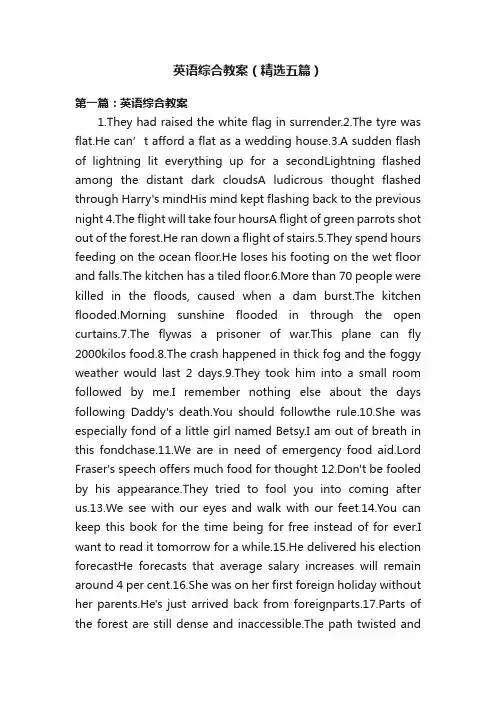
英语综合教案(精选五篇)第一篇:英语综合教案1.They had raised the white flag in surrender.2.The tyre was flat.He can’t afford a flat as a wedding house.3.A sudden flash of lightning lit everything up for a secondLightning flashed among the distant dark cloudsA ludicrous thought flashed through Harry's mindHis mind kept flashing back to the previous night4.The flight will take four hoursA flight of green parrots shot out of the forest.He ran down a flight of stairs.5.They spend hours feeding on the ocean floor.He loses his footing on the wet floor and falls.The kitchen has a tiled floor.6.More than 70 people were killed in the floods, caused when a dam burst.The kitchen flooded.Morning sunshine flooded in through the open curtains.7.The flywas a prisoner of war.This plane can fly 2000kilos food.8.The crash happened in thick fog and the foggy weather would last 2 days.9.They took him into a small room followed by me.I remember nothing else about the days following Daddy's death.You should followthe rule.10.She was especially fond of a little girl named Betsy.I am out of breath in this fondchase.11.We are in need of emergency food aid.Lord Fraser's speech offers much food for thought 12.Don't be fooled by his appearance.They tried to fool you into coming after us.13.We see with our eyes and walk with our feet.14.You can keep this book for the time being for free instead of for ever.I want to read it tomorrow for a while.15.He delivered his election forecastHe forecasts that average salary increases will remain around 4 per cent.16.She was on her first foreign holiday without her parents.He's just arrived back from foreignparts.17.Parts of the forest are still dense and inaccessible.The path twisted andturned through the forest.18.She forgot where she left the car and it took us two days to find it.I hope you will forget about the bad experience you had today.19.There is a sharp point on a forkor pitchfork.20.They received a benefit in the form of a tax reduction...A queue forms outside Peter's study...She thought she'd never been so glad to see his bulky form.You will be asked to fill in a form with details of your birth and occupation.21.She fell forwards on to her face.People should forget and look forwardsThree policeman step forwardand raise their rifles.I'll take the right forwardzone.Please move your car forward.22.A fountain is an ornamental feature in a pool or lake which consists of a long narrow stream of water that is forced up into the air by a pump.Ancient greece was a fountainof wisdom and philosophy.23.We followed the fox's tracks and caught it.24.The elections were free and fair...There was hardly any freetime.We get Freeupgrades and technical supportAppointment booking services are freeof charge.He wa kind and set the hare free so that it got freedom.25.If the temperature drops below 0°C, water freezes.You can freeze the soup at this stageWhat if it rained and then froze all through those months?Code freezefive minutes before end of contest.It is cold and the temprerature has dropped to the freezing point.26.Fresh food has been picked or produced recently, and has not been preserved, for example by being frozen or put in a tinThe morning freshair makes me feel quit frisky.They bring a fresh point.27.I have been fixing the fridgeall the morning.Anything moldy in the fridge?28.Friendship the older it grows the stronger it is..We are not friendly to foreigners.29.We are frightened to hear the frightening sound.30.From then on ,the enemies searched me from door to door.They live from door to door.31.Stand at thefront of the lineShe was only six and still missing her front teeth.The Guardian's front page carries a photograph of the two foreign ministers.Sonja's husband is fighting at the front.32.It was bitterly cold now and the ground was frozen hard.Frozen fish is a very healthy convenience food 33.Like tree,like fruit.Action is the proper fruit of knowledge.34.Fry the breadcrumbs until golden brown.She cuts and fries the mixture up into a potato doughnut called Quin-Kuria.35.They ran out of fuel and the car stopped.36.Reading makes a full man.Once the container is full, it stays shut until you turn it clockwise.I feel full of confidence and so open to possibilities.The main car park was full when I left about 10.45.People would go into the store and come out with their arms full.37.It was such a success and we had so much fun doing it.It could be fun to watch themLiz was wonderful fun to be with.38.I'll tell you a funny story.Children get some very funny ideas sometimes!.39.Each piece of furniture in their home suited the style of the house.This furniturebelonged to him.40.He was making plans for the future...There's no future in this relationship. 第二篇:综合英语III教案课程名称:综合英语III课程代码:开课系部:外语系授课教师:授课班级: XX级英语本科班开课学期: 201X-201X第一学期教案一、课程简介课程类别:专业必修课授课对象:本科英语专业学时学分:68学时;学分2分使用教材:杨立民,《现代大学英语》,外语教学与研究出版社,2011年。
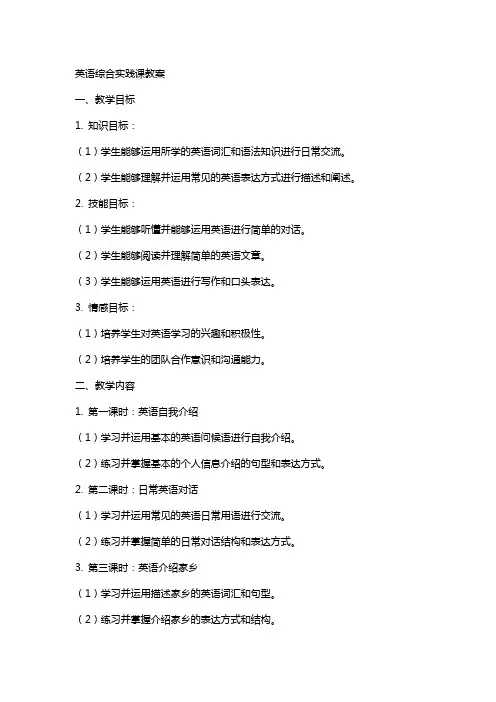
英语综合实践课教案一、教学目标1. 知识目标:(1)学生能够运用所学的英语词汇和语法知识进行日常交流。
(2)学生能够理解并运用常见的英语表达方式进行描述和阐述。
2. 技能目标:(1)学生能够听懂并能够运用英语进行简单的对话。
(2)学生能够阅读并理解简单的英语文章。
(3)学生能够运用英语进行写作和口头表达。
3. 情感目标:(1)培养学生对英语学习的兴趣和积极性。
(2)培养学生的团队合作意识和沟通能力。
二、教学内容1. 第一课时:英语自我介绍(1)学习并运用基本的英语问候语进行自我介绍。
(2)练习并掌握基本的个人信息介绍的句型和表达方式。
2. 第二课时:日常英语对话(1)学习并运用常见的英语日常用语进行交流。
(2)练习并掌握简单的日常对话结构和表达方式。
3. 第三课时:英语介绍家乡(1)学习并运用描述家乡的英语词汇和句型。
(2)练习并掌握介绍家乡的表达方式和结构。
4. 第四课时:英语讲述故事(1)学习并运用讲述故事的英语词汇和句型。
(2)练习并掌握讲述故事的表达方式和结构。
5. 第五课时:英语讨论兴趣和爱好三、教学方法1. 情境教学法:通过设定各种真实的语境,让学生在实际的语言环境中学习和应用英语。
2. 交际教学法:通过模拟真实的交流场景,让学生在互动和对话中学习和应用英语。
3. 任务型教学法:通过完成各种实际的英语任务,让学生在实践中学习和应用英语。
四、教学评价1. 课堂参与度:观察学生在课堂上的参与情况和积极性。
2. 语言运用能力:通过口语表达和写作练习评估学生的语言运用能力。
3. 学习效果:通过测试和作业评估学生的学习效果和掌握程度。
五、教学资源1. 教材:英语综合实践课教材。
2. 教具:投影仪、电脑、黑板、粉笔等。
3. 辅助材料:英语对话剧本、故事素材、兴趣和爱好相关的话题等。
六、第六课时:英语描述人物1. 学习并运用描述人物的外貌、性格和能力的英语词汇和句型。
2. 练习并掌握描述人物的表达方式和结构。
第1篇一、教学背景随着全球化的推进,英语口语交际能力已成为当代学生必备的基本素养之一。
在我国新课程改革背景下,英语教学越来越重视学生的实际应用能力培养。
本实践作业旨在通过设计一系列口语交际活动,帮助学生提高英语口语表达能力,增强跨文化交流意识。
二、教学目标1. 知识目标:学生能够掌握一定的英语口语交际策略,如问候、介绍、表达意见等。
2. 能力目标:学生能够运用所学知识进行日常生活中的英语口语交际,提高实际应用能力。
3. 情感目标:激发学生学习英语的兴趣,培养学生良好的学习习惯和跨文化交流意识。
三、教学对象初中二年级学生,具备一定的英语基础,但口语表达能力相对较弱。
四、教学时间2课时五、教学过程第一课时1. 导入(1)播放一段英语口语交际视频,引导学生观察并思考:视频中的人物是如何进行口语交际的?有哪些技巧值得我们学习?(2)教师总结视频中的口语交际技巧,引出本节课的主题——英语口语交际能力提升。
2. 新课导入(1)教师展示一张图片,如餐厅、商场等,引导学生用英语描述图片内容,并运用所学口语交际技巧。
(2)教师根据学生的描述,适时给予评价和指导。
3. 课堂活动(1)小组讨论:学生分组,围绕一个话题进行讨论,如“我的家乡”、“我的爱好”等,要求用英语表达。
(2)角色扮演:学生根据讨论内容,分组进行角色扮演,模拟真实场景进行口语交际。
4. 课堂小结教师总结本节课所学内容,强调英语口语交际技巧的重要性,鼓励学生在日常生活中多加练习。
第二课时1. 复习导入(1)教师提问:上一节课我们学习了哪些英语口语交际技巧?请同学们举例说明。
(2)学生分享所学内容,教师进行补充和总结。
2. 新课导入(1)教师展示一张图片,如医院、机场等,引导学生用英语描述图片内容,并运用所学口语交际技巧。
(2)教师根据学生的描述,适时给予评价和指导。
3. 课堂活动(1)情景模拟:学生分组,模拟不同场景进行口语交际,如购物、问路、求助等。
英语综合实践教案教案标题:英语综合实践教案教案目标:1. 帮助学生提高英语听、说、读、写的能力。
2. 培养学生的英语综合运用能力,使其能够在实际情境中流利、准确地运用英语进行交流。
3. 激发学生学习英语的兴趣和积极性。
教学重点:1. 提高学生的听力和口语能力,培养他们的语音、语调和语音语调的准确性。
2. 培养学生的阅读理解能力,提高他们的阅读速度和准确性。
3. 强化学生的写作能力,提高他们的写作表达能力和语法正确性。
教学内容和步骤:第一课时:英语听力训练1. 创造一个真实的听力情境,例如通过播放录音或使用多媒体设备播放英语对话或短文。
2. 引导学生仔细聆听,理解并回答与听力材料相关的问题。
3. 鼓励学生进行听力材料的反复练习,提高他们的听力技巧和理解能力。
第二课时:英语口语训练1. 提供一些与学生生活相关的话题,例如日常活动、个人喜好等,鼓励学生进行口语表达。
2. 组织学生进行小组或伙伴间的对话练习,鼓励他们积极参与和互动。
3. 提供一些角色扮演的活动,让学生在模拟情境中进行口语表达,如在商店购物、旅行等场景中进行对话。
第三课时:英语阅读训练1. 选择适合学生水平的英语阅读材料,如短文、新闻报道等。
2. 引导学生阅读材料,并提出相关的问题,检验他们对材料的理解程度。
3. 组织学生进行阅读材料的讨论和分享,促进他们的思维和交流能力。
第四课时:英语写作训练1. 提供一些写作话题,如个人经历、旅行见闻等,鼓励学生进行写作练习。
2. 引导学生进行写作素材的收集和整理,帮助他们构思文章结构和内容。
3. 逐步引导学生进行写作,注重语法和词汇的正确性,并提供反馈和指导。
教学评估:1. 在每个课时结束时进行小测验,检验学生对所学内容的掌握情况。
2. 通过听、说、读、写的综合测试,评估学生的英语综合实践能力。
3. 鼓励学生进行自我评估,帮助他们认识自己的学习进步和不足之处。
教学资源:1. 多媒体设备,如电脑、投影仪等,用于播放听力材料和展示教学内容。
小学英语综合实践活动教案一、活动主题:英语角——介绍我的家人二、活动目标:1. 学生能够用英语简单介绍自己的家人。
2. 学生能够听懂并运用常见的家庭成员词汇。
3. 提高学生的口语表达能力和团队合作意识。
三、活动准备:1. 教师准备家庭成员词汇卡片。
2. 学生准备家庭成员照片或手工作品。
四、活动过程:1. 热身活动(5分钟):唱一首关于家庭的英文歌曲,如《Family Tree》。
2. 家庭成员词汇学习(10分钟):教师分发词汇卡片,引导学生学习家庭成员词汇,如mother, father, sister, brother等。
3. 小组活动(15分钟):学生分成小组,每组选择一张家庭成员照片或手工作品,用英语介绍自己的家人,其他小组成员倾听并给予反馈。
4. 展示环节(10分钟):每个小组派代表上台,向全班同学介绍自己的家人,其他同学听后进行评价。
5. 总结环节(5分钟):教师对学生的表现进行点评,强调口语表达的重要性和团队合作的精神。
五、作业布置:1. 学生回家后,尝试用英语向家人介绍自己的家人,并记录下来。
2. 学生准备一首关于家庭的英文歌曲,下节课分享。
六、活动主题:英语角——我的学校生活七、活动目标:1. 学生能够用英语描述自己的学校生活。
2. 学生能够听懂并运用常见的学校相关词汇。
3. 提高学生的口语表达能力和团队合作意识。
八、活动准备:1. 教师准备学校相关词汇卡片。
2. 学生准备学校照片或手工作品。
九、活动过程:1. 热身活动(5分钟):唱一首关于学校的英文歌曲,如《Going to School》。
2. 学校相关词汇学习(10分钟):教师分发词汇卡片,引导学生学习学校相关词汇,如classroom, teacher, student, school等。
3. 小组活动(15分钟):学生分成小组,每组选择一张学校照片或手工作品,用英语描述自己的学校生活,其他小组成员倾听并给予反馈。
4. 展示环节(10分钟):每个小组派代表上台,向全班同学介绍自己的学校生活,其他同学听后进行评价。
英语综合实践活动课教案一、教学目标1. 提高学生的英语口语表达能力。
2. 培养学生的团队协作精神。
3. 提升学生的跨文化交际能力。
4. 增强学生对英语学习兴趣。
二、教学内容1. 英语口语表达:通过小组讨论、角色扮演等形式,让学生在实际场景中运用英语进行交流。
2. 团队协作:学生分组进行活动,培养他们在团队中的协作能力和沟通能力。
3. 跨文化交际:介绍不同国家的文化背景,让学生了解并尊重文化差异。
4. 英语游戏:设计有趣的英语游戏,让学生在游戏中学习英语。
三、教学方法1. 任务型教学法:通过设置各种任务,让学生在完成任务的过程中学习英语。
2. 交际法:鼓励学生进行口语交流,提高他们的交际能力。
3. 情境教学法:创设真实的语言环境,让学生在实际场景中学习英语。
4. 游戏教学法:设计丰富的英语游戏,激发学生的学习兴趣。
四、教学步骤1. 热身活动:引导学生进行简单的英语自我介绍,营造轻松的课堂氛围。
2. 口语表达:分组进行话题讨论,鼓励学生发表自己的观点。
3. 团队协作:学生分组完成指定的任务,培养他们的协作能力。
4. 跨文化交际:介绍不同国家的文化背景,引导学生进行跨文化交流。
5. 英语游戏:组织学生参与英语游戏,提高他们的学习兴趣。
五、作业与评价2. 评价:教师对学生的课堂表现进行评价,关注他们的口语表达、团队协作和跨文化交际能力。
3. 反馈:及时给予学生反馈,鼓励他们不断提高。
六、教学资源1. 教材:选用适合学生的英语综合实践活动教材。
2. 多媒体设备:投影仪、电脑、音响等。
3. 教具:图片、卡片、实物等。
4. 网络资源:相关英语学习网站、视频等。
七、教学环境1. 教室布局:座位排列便于学生交流和互动。
2. 氛围营造:轻松、愉快的课堂氛围,鼓励学生积极参与。
3. 设施设备:确保多媒体设备正常运行,网络畅通。
八、教学评价1. 过程评价:关注学生在课堂活动中的参与程度、口语表达和团队协作能力。
2. 成果评价:评价学生课后作业,了解他们对课堂所学内容的掌握情况。
2024年小学英语综合实践活动计划一、教学理念兴趣作为学生学习的内在动力,对于培养英语学习热情至关重要。
鉴于小学阶段英语学习环境的局限性,学生往往面临记忆遗忘的挑战,出现“学时记得、用时忘记”的现象。
这种现象若长期存在,可能导致部分学生成绩下滑,逐渐丧失对英语学习的兴趣,进而影响教师的教学质量。
因此,小学英语教学应着眼于学生的实际需求,同时关注其未来学习与发展。
仅仅依赖课堂内的教学无法充分满足学生学习英语的需求,我们需树立以大课堂为核心的教学观念,并重视课外实践活动的开展。
课外活动作为课堂教学的辅助与延伸,对于培养学生学习兴趣至关重要。
为此,我们特开展小学英语综合实践活动,旨在丰富学生的课余生活。
二、活动宗旨1. 通过组织有效的课外活动,从小培养小学生对英语及其学习的浓厚兴趣。
2. 教授学生学习方法,培养其英语学习能力,实现“授人以渔”的教学目标。
3. 培养学生良好的行为习惯,塑造健康的个性心理。
4. 提升学生的综合素质,为未来英语学习打下坚实基础。
三、活动内容本学期,我们将通过“绿色作业”这一形式开展学科实践活动。
学生通过参与绿色作业的实践与完成,不仅能够丰富英语知识,还能显著提升学习兴趣,拓宽思维视野,并从英语的视角发现世界的多样性。
四、活动范围活动对象涵盖一至六年级全体学生。
五、参与要求每位学生均需按时参加综合实践活动,并在活动中积极投入,展现出团结协作的精神。
六、实施措施英语教研组将依据教材内容,设计合理且有效的绿色作业。
学生需自主认真完成各自分配的绿色作业,教师将从中挑选优秀作业进行展评。
学生的作业完成情况将作为其英语成绩的组成部分,以激励学生积极参与并认真对待综合实践活动。
2024年小学英语综合实践活动计划(二)本计划旨在贯彻落实培养学生综合素质的教育方针,特制定小学英语综合实践活动方案,以期激发学生的学习兴趣,增强学习积极性,并丰富课余生活。
一、指导思想本活动秉承培养学生学习英语兴趣的宗旨,通过多元化的实践活动,旨在激发小学生对英语学习的热情,同时充实其课余生活。
英语综合实践课教案----小小英语表演家班级:七年级(2)班教师:樊春淼活动名称:小小英语表演家活动目的:指导学生综合运用所学知识,自设情景,自编对话,激发其学习兴趣,培养学生自主探索。
自主创造和运用语言交际的能力和创新精神,互相帮助和团结合作的精神。
活动内容分析:学生经过二、三年多的英语学习,能进行一些简单的对话活动。
但是,如何综合运用己学知识、用正确的语音、语调进行实践交际活动是学生学习英语过程中的重点、难点。
因此,这课将通过活动重点解决这方面的问题。
活动准备:丰富的活动背景、单词图片、实物、玩具等。
活动要求:人人参与,主动参与。
自编对话合情合理,参与表演自然大方,语音、语调正确。
活动方法与顺序:一、基本训练,创设语言氛围。
(三分钟)1、同学们相互问候。
2、英语报数。
3、唱英文歌。
Head,shoulders,knees and toes4、师生相互问候。
二、复习旧知。
(六分钟)老师说明活动要求:以小组为单位,以图片为内容进行自由交谈。
(注:这样的设计力图在提高复习强度的同时冲破课堂的柬缚,让学生在轻松、自由的环境中主动参与到学习中去。
)三、轻松三分钟。
(三分钟)1、请语音、语调好的同学上台喊口令,其余学生听音做动作。
如:Touch your nose/face/eye/. Stand up . Sit down ….2、齐唱英文歌。
Fly ,fly ,fly ,the butterfly.(注:惜助此环节形成生动活泼的氛围,激发学生学习兴趣,是他们在愉悦的情绪中进行下一环节的练习。
)四、自设情景,表演对话。
(二十七分钟)老师交代活动的要求:每一组同学选择实物,或者看图所给情景(Go shopping,利用老师带来头饰或照片人物介绍朋友家人等等)请利用它们为道具,自己编情景对话。
请按以下步骤进行:1、Ora1 practice,(口头练习)(四分钟)要求:口头讨论、练习,不动道具。
2、Choose the role,then practice.(六分钟)(角色实践)要求:进行角色分配,再利用道具在原地自设情景,练习对话。
英语综合实践课教案----小小英语表演家
班级:七年级(2)班教师:樊春淼
活动名称:小小英语表演家
活动目的:
指导学生综合运用所学知识,自设情景,自编对话,激发其学习兴趣,培养学生自主探索。
自主创造和运用语言交际的能力和创新精神,互相帮助和团结合作的精神。
活动内容分析:
学生经过二、三年多的英语学习,能进行一些简单的对话活动。
但是,如何综合运用己学知识、用正确的语音、语调进行实践交际活动是学生学习英语过程中的重点、难点。
因此,这课将通过活动重点解决这方面的问题。
活动准备:丰富的活动背景、单词图片、实物、玩具等。
活动要求:人人参与,主动参与。
自编对话合情合理,参与表演自然大方,语音、语调正确。
活动方法与顺序:
一、基本训练,创设语言氛围。
(三分钟)
1、同学们相互问候。
2、英语报数。
3、唱英文歌。
Head,shoulders,knees and toes
4、师生相互问候。
二、复习旧知。
(六分钟)老师说明活动要求:以小组为单位,以图片为内容进行自由交谈。
(注:这样的设计力图在提高复习强度的同时冲破课堂的柬缚,让学生在轻松、自由的环境中主动参与到学习中去。
)
三、轻松三分钟。
(三分钟)
1、请语音、语调好的同学上台喊口令,其余学生听音做动作。
如:
Touch your nose/face/eye/. Stand up . Sit down ….
2、齐唱英文歌。
Fly ,fly ,fly ,the butterfly.(注:惜助此环节形成生动活泼的氛围,激发学生学习兴趣,是他们在愉悦的情绪中进行下一环节的练习。
)
四、自设情景,表演对话。
(二十七分钟)老师交代活动的要求:每一组同学选择实物,或者看图所给情景(Go shopping,利用老师带来头饰或照片人物介绍朋友家人等等)请利用它们为道具,自己编情景对话。
请按以下步骤进行:
1、Ora1 practice,(口头练习)(四分钟)
要求:口头讨论、练习,不动道具。
2、Choose the role,then practice.(六分钟)
(角色实践)
要求:进行角色分配,再利用道具在原地自设情景,练习对话。
3、Say and do in the group, then choose 4 better
groups.四个大组,八个小组。
各小组在所属大组的表演区里表演对话,每个大组评出表演效果好的一组到全班展示。
4、Say and do in class.(全班展示)(九分钟)
(1)全班展示。
(2)同学评价。
(注:在道具方面,我选用了学生熟悉、喜爱的玩具、头饰用来扮演人物或角色。
引导学生进行购物语言的运用和介绍家人,朋友。
在表演中注重学生的自我评价,教师可了解学生的知识掌握情况,更能促使学生认真、主动参与这一活动,从而评价的结果是激发学生充分发展语言交际能力。
)
五、教师对活动情况进行总结。
(一分钟)拍照方法鼓励学生,激发学生学习的成就感,和学习兴趣。